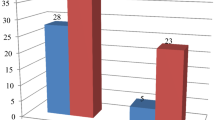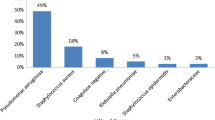Abstract
A prospective study was done to determine the clinico-microbiological profile and the antibiogram of patients with chronic suppurative otitis media. Ninety-four patients presenting with tympanic perforation and ear discharge of more than 3 months were studied. Middle ear swabs obtained aseptically were processed for culture and the isolates identified by standard procedures. Antimicrobial susceptibility testing of the aerobic bacterial isolates was performed by disc diffusion method according to clinical laboratory standards institute guidelines. Patients in the age group of 21–30 years were more commonly affected (22.3%). Male:Female ratio was 2:1.4. Of the 94 patients, 64 (68.1%) had tubo-tympanic disease and rest 30 (31.9%) presented with attico-antral disease. Monomicrobial flora was seen in 55 (58.5%) samples, 28 (29.8%) yielded polymicrobial growth and 11 (11.7%) samples were sterile. A total of 115 microbial isolates (86 aerobic bacteria, 18 anaerobic bacteria and 11 fungi) were obtained. Pseudomonas aeruginosa (32.2%) was the most common isolate followed by Staphylococcus aureus (17.4%). Amongst anaerobes, gram positive cocci were more commonly isolated (38.9%). Aspergillus spp. (72.7%) were the most common fungus isolated. Most of the Pseudomonas aeruginosa isolates (25, 67.6%) were susceptible to all the antibiotics. Among the commonly used topical agents in the treatment of CSOM, tobramycin was the most effective (83.8%), followed by gentamicin (78.1%), ciprofloxacin (75.6%) and neomycin (3.5%). Periodic monitoring of the microbiological profile along with their sensitivity pattern is essential for formulating an effective antibiotic policy for CSOM.
Similar content being viewed by others
References
Loy AHC, Tan AL, Lu PKS (2002) Microbiology of chronic suppurative otitis media in Singapore. Singapore Med J 43:296–299
Verhoeff M, van der Veen EL, Rovers MM, Sanders EAM, Schilder AGM (2006) Chronic suppurative otitis media: a review. Int J Pediatr Otorhinolaryngol 70:1–12
Youngs R (1998) Chronic suppurative otitis media. In: Ludman H, Wright T (eds) Diseases of the ear, Chapter 27–29, 6th edn. Arnold Publishers, London, pp 374–415
Olu Ibekwe A, Shareef ZA, Benayam A (1997) Anaerobes and fungi in chronic suppurative otitis media. Ann Otol Rhinol Laryngol 106:649–652
Dhingra PL, Dhingra S (2010) Cholesteatoma and chronic otitis media. In: Diseases of Ear, Nose and Throat, Chapter 11, 5th edn. Elsevier, New Delhi, pp 75–83
Collee JG, Miles RS, Watt B (1996) Tests for identification of bacteria. In: Collee JG, Fraser AG, Marmion BP, Simmons A (eds) Mackie and McCartney practical medical microbiology, Chapter 7, 14th edn. Churchill Livingstone, New York, pp 131–149
Jousimies-Somer H, Summanen P, Citron DM, Baron EJ, Wexler HM, Finegold SM (2002) Preliminary identification methods. In: Wadsworth-KTL anaerobic bacteriology manual, 6th edn, Chapter 4. Star publishing Company, California, pp 55–74
Clinical and Laboratory Standards Institute (2007) Performance standards for antimicrobial susceptibility testing. Seventeenth informational supplement. CLSI document M100–S17. Clinical and Laboratory Standards Institute, Wayne, Pennsylvania
Tofteland S, Haldorsen B, Dahl KH, Simonsen GS, Steinbakk M, Walsh TR et al (2007) Effects of phenotype and genotype on methods for detection of extended-spectrum-beta-lactamase-producing clinical isolates of Escherichia coli and Klebsiella pneumoniae in Norway. J Clin Microbiol 45:199–205
Yeo SG, Park DC, Hong SM, Cha CI, Kim MG (2007) Bacteriology of chronic suppurative otitis media—a multicenter study. Acta Otolaryngol 127:1062–1067
Maji PK, Chatterjee TK, Chatterje S, Chakrabarthy J, Mukhopadhyaya BB (2007) The investigation of bacteriology of chronic suppurative otitis media in patients attending a tertiary care hospital with special emphasis on seasonal variation. Indian J Otolaryngol Head Neck Surg 59:128–131
Indudharan R, Ashraful Haq J, Aiyar S (1999) Antibiotics in chronic suppurative otitis media: a bacteriological study. Ann Otol Rhinol Laryngol 108:440–445
Haynes DS, Rutka J, Hawke M, Roland PS (2007) Ototoxicity of ototopical drops—an update. Otolaryngol Clin N Am 40:669–683
Conflicts of interest
None.
Author information
Authors and Affiliations
Corresponding author
Rights and permissions
About this article
Cite this article
Vishwanath, S., Mukhopadhyay, C., Prakash, R. et al. Chronic Suppurative Otitis Media: Optimizing Initial Antibiotic Therapy in a Tertiary Care Setup. Indian J Otolaryngol Head Neck Surg 64, 285–289 (2012). https://doi.org/10.1007/s12070-011-0287-6
Received:
Accepted:
Published:
Issue Date:
DOI: https://doi.org/10.1007/s12070-011-0287-6




